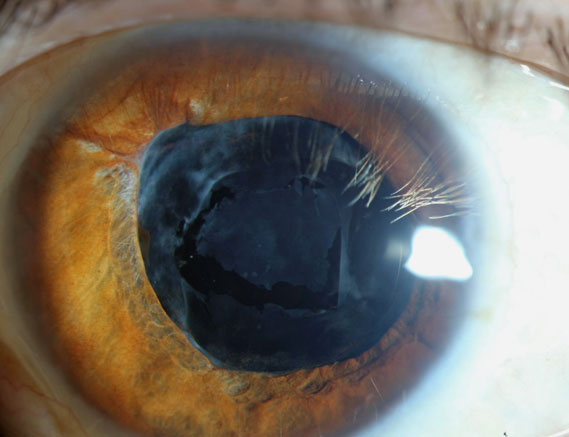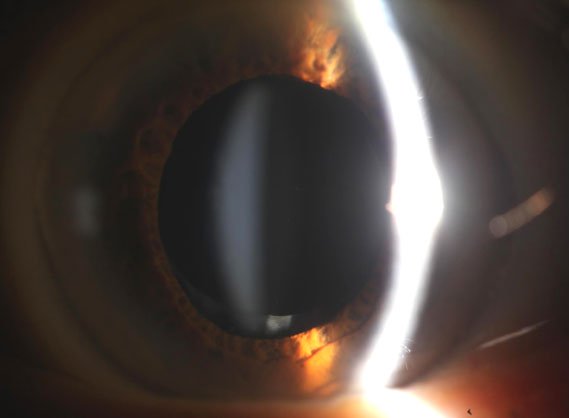BLOG: When opacification is not caused by PCO
Click Here to Manage Email Alerts
Relatively frequently we’ll be assessing an IOL in clinic and be struck by some degree of opacification of the lens or the capsule. Most commonly, what we are seeing is posterior capsular opacification, a postoperative problem all optometrists are familiar with.
That said, posterior capsular opacification (PCO) is far from the only thing to compromise the optics of the IOL-capsular apparatus, and it’s really one of the only easily treatable sources of compromise here. Unfortunately, most of these other sources of reduced optics are unfamiliar to practicing ODs and can be overlooked, mistaken for PCO or just present a source of confusion.
History of PCO
First of all, as an introduction, let’s talk about PCO. In the genesis of modern cataract surgery as the capsule was first being recycled to support the IOL rather than just being removed, PCO – which is a migration and proliferation of residual equatorial lens epithelium not removed at the time of cataract surgery – was felt to be a nearly universal, unavoidable consequence of the operation. It wasn’t until the introduction of one of the first modern IOLs, the squared-edge Acrysof MA60BM (Alcon), that rates of PCO noticeably dropped. Eventually this drop was correctly attributed to an unintended benefit of the lenses new squared-edge design. This squared edge “bit” more tightly into the lens capsule and therefore presented a more robust physical barrier to lens epithelial migration and subsequent PCO development than the previous generation’s round-edge designs.
From this point on, all widely used modern IOLs have been designed with a square edge to capture this benefit (at the likely expense of increased dysphotopsias). Although rates of PCO are lower with modern IOLs than they were previously, it remains the most common late complication of cataract surgery with up to 50% of patients requiring a YAG capsulotomy by 5 years postoperatively (Boulton et al.).
An interesting variant on this theme of PCO developing late after surgery are cases where it seemingly appears the day after surgery. How can it be possible that we are getting lens epithelial migration and proliferation this soon after surgery? The answer, of course, is that we aren’t seeing PCO in the traditional sense, rather we are looking at residual cataract that is stuck on the capsule. During surgery, after the lens material is removed from the capsule, certain cataracts – posterior subcapsular and posterior polar in particular – can leave behind a residual plaque on the posterior capsule. At this point, the surgeon will be faced with the option of attempting to polish this residual opacity off the capsule.
While it is simple to say, “the surgeon will polish the capsule,” the actual process is more of a high-wire balancing act. If the surgeon is successful in polishing, the optics of the IOL-capsule apparatus are pristine. However, if they polish too aggressively (a threshold that is unique to each capsule), they may rupture the posterior capsule and then are faced with all the headaches that go along with this (increased risk of cystoid macular edema, retinal detachments, infection, vitreal migration and decreased long-term stability of the IOL). Like more typical late-onset PCO, early postop PCO is easily treated with a YAG laser, which we know is a very safe and effective procedure in contrast to aggressive intraoperative polishing of a lens capsule. In general, it’s advised to wait a few months to allow the capsule and IOL to fibrose. So, in many cases, the surgeon will polish these residual plaques to a degree, but if the plaque isn’t amenable to removal with gentle pressure, the surgeon will sometimes be satisfied to leave this to be safely YAG’ed down the road.
Again, this is easy for us as eye doctors to understand, but more difficult for the uneducated patient to accept when they are told a day or week after surgery that they will need a YAG laser to remove residual cataract. To avoid this disappointment, it is always wise to emphasize to patients with significant posterior subcapsular cataracts or posterior-polar cataracts that they are at an increased risk of needing a YAG laser a few months after their surgery. We’ve found that the disappointment of this step is almost always avoidable with appropriate preoperative education.

Capsular striae
Although PCO is very common after modern cataract surgery, it is likely only the second most common irregularity of the IOL capsule apparatus. The most common issue here is probably what is termed capsular striae or capsular tension lines, which are simply sharp lines running through the posterior capsule. One group estimates that at the 1-month postoperative exam, between 30% and 60% of patients have these capsular striae, with the most commonly used modern IOLs, the AMO Tecnis and Alcon Acrysof (Nagata et al.).
The origin of these wrinkles is interesting if for no other reason than it illustrates a very intuitive mechanical cause and effect of cataract surgery. The direction of these wrinkles is always approximately parallel to the direction of the haptic of the IOL. The haptics will stretch the capsule in the direction they run; that is, vertically oriented haptics will stretch the capsule vertically. However, there is no counter tension in the opposite meridian, so redundant capsule bunches up along the stretched meridian. In the case of our vertically oriented haptics, this results in redundant capsule that bunches up in these vertical lines.
Fortunately, in most cases, patients are asymptomatic of these disturbances. But as soon as they say, “Every point source of light has lines running through it this direction,” and they raise their arm to show you the orientation of these lights, you know that patient has a capsular striae and you also know the striae will be oriented perpendicularly to their perception of light. The reason for this specific symptom is these striae will occasionally cause a Maddox-Rod phenomenon, that is, a perpendicular splaying of light relative to the striae. In many cases this symptom fades over the first few months, but in cases where it persists, a YAG capsulotomy is an easy fix.
Capsular bag distension syndrome
A less common postoperative abnormality of the posterior capsule that occurs most typically in the early postoperative course (although very late-onset cases are possible as well) and is sometimes overlooked in clinic is called capsular bag distension syndrome (CBDS) or capsular block syndrome. This entity is an umbrella term for any case where fluid – whether it’s surgical viscoelastic or aqueous – becomes sequestered in the space between the posterior capsule and posterior optic of the IOL. Although the precise makeup of the eventual fluid is variable, it’s thought that retained viscoelastic in this space is the seeding event.
It is very common to see some fluid in this space the day after cataract surgery. However, over the first week, in almost all cases the capsule contracts around the IOL, and space collapses. In cases where this fluid is stagnant, and the space does not collapse, it becomes turbid and cloudy and can mimic the appearance and optical impact of typical PCO. The clue here on exam is that the thickness of this fluid is many times that of PCO. Differentiating these two entities is ultimately unimportant beyond just striving to be correct in our assessment as the treatment, YAG posterior capsulotomy, and response to treatment is the same as with PCO.
A second variant of CBDS occurs when fluid is continually introduced into this space without exiting, resulting in a dramatic expansion of the space. The exact source of this fluid is not clear, but unbalanced osmotic gradients are suspected, and the result is often a myopic shift as the IOL is driven anteriorly, increasing its effective power. Subsequently, a reduction in uncorrected acuity and occasionally elevated IOP will occur as this anterior displacement of the IOL can cause the iris to be pushed into the angle. Again, the response to YAG capsulotomy is definitive, although these cases are a little trickier to diagnose, as the posterior capsule is driven far into the anterior vitreous, giving the illusion of a totally clear capsule on cursory evaluation of the IOL. However, if you look further into the anterior vitreous with direct viewing (i.e., not using a condensing lens) the bowed posterior capsule will be encountered, and the diagnosis is clear.

Capsular phimosis
Capsular phimosis is another common irregularity in the lens capsule but is a term that is, unfortunately, unfamiliar to many ODs. Capsular phimosis is likely caused by a mechanism similar to PCO, that is, migration and proliferation of residual lens epithelial cells, which, in this case, cause annular contraction and fibrosis of the anterior capsulorrhexis. This condition tends to develop months and years after cataract extraction and can be viewed on dilated exam as very prominent without being visually significant. Once the contraction occurs within the zone of the undilated pupil, however, visual symptoms develop.
Treatment here is also accomplished with a YAG, but the response to the laser is quite different than when it is applied to the posterior capsule. The posterior capsule develops a sort of stretched tension as it fibroses around the IOL, and this tension causes a peripherally directed recoil of the capsule out of the visual axis when YAG is applied. The anterior capsule is open centrally and, therefore, is not “on-stretch” in this way. So, while radially applied YAG shots can cause the phimotic area to widen slightly, the openings achieved here are generally more modest than those for PCO. That said, an additional benefit of anterior YAG for phimosis, despite its limitations, is that it can prevent further central constriction of the capsule.
Further, the reduced efficacy of the YAG with anterior phimosis is mirrored with all other nonposterior capsular applications of the laser to the IOL-capsule apparatus. “Dusting” deposits that may be inflammatory calcific or iatrogenic or fibrotic recurrent anterior “pseudo-capsules” with the YAG laser is often unnecessary, as these seldom reduce vision. In addition, in cases where they do, YAG is often only partially successful in their removal and is much more likely to result in pitting of the IOL than with PCO. However, despite its limitations, in cases of deposits that are causing a significant reduction in vision, YAG is often the first step attempted, because the only other options are fully surgical options, but the patient should be carefully educated on the potential of the treatment failing.

Although most postoperative capsular abnormalities are PCO in nature, many are not, and their differentiation is essential for appropriate patient counseling on prognosis, as the response to YAG is variable among causes. For our optometry residents, whose struggle to sometimes differentiate these entities probably approximates the struggle many community ODs have when scrutinizing the IOL-capsule apparatus, we often emphasize the importance of taking time to assess all components of this apparatus as the separate entities they are. The anterior capsulorrhexis should be visualized, and moving beyond this with a wide angle on the slit lamp you will encounter the optic of the IOL. Pushing further into the eye allows direct visualization of the posterior capsule; and, of course, to do all this, you must dilate the eye, so don’t forget this simple, but sometimes overlooked, step in the assessment of the IOL-capsule. Thinking about these distinct structures as layers (rather than all one thing) and trying to differentiate the layer you are dealing with can help with correct diagnosis, patient education and appropriate referral back to the surgical center, and it makes you as the referring OD look good!

References:
Boulton M, Saxby LA. Secondary cataract. In: Yanoff M and Duker JS eds. Ophthalmology, 4th ed. St Louis: Werner; 2014:348-407.
Nagata M, et al. Posterior capsule wrinkle after cataract surgery. Presented at: European Society of Cataract and Refractive Surgeons Congress; London; Sept. 13-17, 2014.
